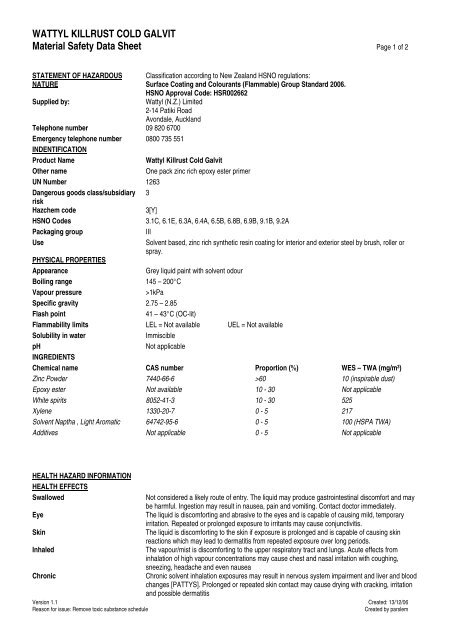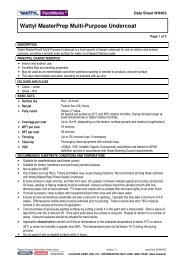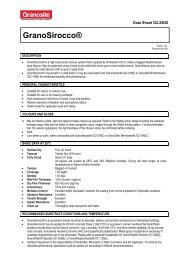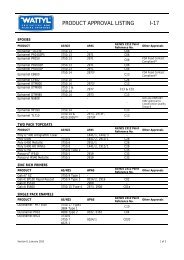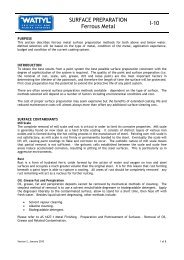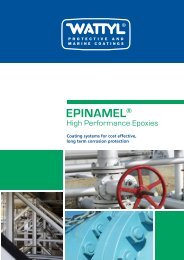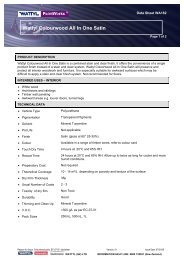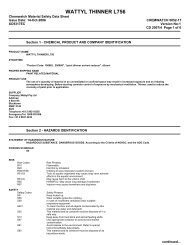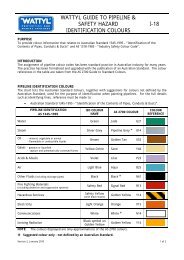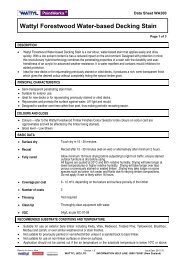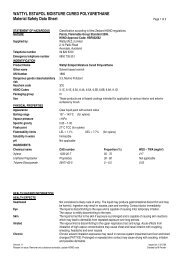WATTYL KILLRUST COLD GALVIT Material Safety Data Sheet
WATTYL KILLRUST COLD GALVIT Material Safety Data Sheet
WATTYL KILLRUST COLD GALVIT Material Safety Data Sheet
- No tags were found...
Create successful ePaper yourself
Turn your PDF publications into a flip-book with our unique Google optimized e-Paper software.
<strong>WATTYL</strong> <strong>KILLRUST</strong> <strong>COLD</strong> <strong>GALVIT</strong><br />
<strong>Material</strong> <strong>Safety</strong> <strong>Data</strong> <strong>Sheet</strong> Page 1 of 2<br />
STATEMENT OF HAZARDOUS<br />
NATURE<br />
Supplied by:<br />
Classification according to New Zealand HSNO regulations:<br />
Surface Coating and Colourants (Flammable) Group Standard 2006.<br />
HSNO Approval Code: HSR002662<br />
Wattyl (N.Z.) Limited<br />
2-14 Patiki Road<br />
Avondale, Auckland<br />
Telephone number 09 820 6700<br />
Emergency telephone number 0800 735 551<br />
INDENTIFICATION<br />
Product Name<br />
Wattyl Killrust Cold Galvit<br />
Other name<br />
One pack zinc rich epoxy ester primer<br />
UN Number 1263<br />
Dangerous goods class/subsidiary 3<br />
risk<br />
Hazchem code<br />
3[Y]<br />
HSNO Codes 3.1C, 6.1E, 6.3A, 6.4A, 6.5B, 6.8B, 6.9B, 9.1B, 9.2A<br />
Packaging group<br />
III<br />
Use<br />
PHYSICAL PROPERTIES<br />
Appearance<br />
Solvent based, zinc rich synthetic resin coating for interior and exterior steel by brush, roller or<br />
spray.<br />
Grey liquid paint with solvent odour<br />
Boiling range 145 – 200°C<br />
Vapour pressure<br />
>1kPa<br />
Specific gravity 2.75 – 2.85<br />
Flash point<br />
41 – 43°C (OC-lit)<br />
Flammability limits LEL = Not available UEL = Not available<br />
Solubility in water<br />
Immiscible<br />
pH<br />
Not applicable<br />
INGREDIENTS<br />
Chemical name CAS number Proportion (%) WES – TWA (mg/m³)<br />
Zinc Powder 7440-66-6 >60 10 (inspirable dust)<br />
Epoxy ester Not available 10 - 30 Not applicable<br />
White spirits 8052-41-3 10 - 30 525<br />
Xylene 1330-20-7 0 - 5 217<br />
Solvent Naptha , Light Aromatic 64742-95-6 0 - 5 100 (HSPA TWA)<br />
Additives Not applicable 0 - 5 Not applicable<br />
HEALTH HAZARD INFORMATION<br />
HEALTH EFFECTS<br />
Swallowed<br />
Eye<br />
Skin<br />
Inhaled<br />
Chronic<br />
Not considered a likely route of entry. The liquid may produce gastrointestinal discomfort and may<br />
be harmful. Ingestion may result in nausea, pain and vomiting. Contact doctor immediately.<br />
The liquid is discomforting and abrasive to the eyes and is capable of causing mild, temporary<br />
irritation. Repeated or prolonged exposure to irritants may cause conjunctivitis.<br />
The liquid is discomforting to the skin if exposure is prolonged and is capable of causing skin<br />
reactions which may lead to dermatitis from repeated exposure over long periods.<br />
The vapour/mist is discomforting to the upper respiratory tract and lungs. Acute effects from<br />
inhalation of high vapour concentrations may cause chest and nasal irritation with coughing,<br />
sneezing, headache and even nausea<br />
Chronic solvent inhalation exposures may result in nervous system impairment and liver and blood<br />
changes [PATTYS]. Prolonged or repeated skin contact may cause drying with cracking, irritation<br />
and possible dermatitis<br />
Version 1.1 Created: 13/12/06<br />
Reason for issue: Remove toxic substance schedule<br />
Created by parslem
<strong>WATTYL</strong> <strong>KILLRUST</strong> <strong>COLD</strong> <strong>GALVIT</strong><br />
<strong>Material</strong> <strong>Safety</strong> <strong>Data</strong> <strong>Sheet</strong> Page 2 of 2<br />
FIRST AID<br />
Swallowed<br />
If swallowed do not induce vomiting. Give water to rinse out mouth, then provide water slowly and<br />
as much as the casualty can comfortably drink. Seek medical advice.<br />
Eye Immediately hold eyelids apart and flush the eye continuously with running water for at least 15<br />
minutes. Seek medical advice. Removal of contact lenses should only be undertaken by skilled<br />
personnel.<br />
Skin<br />
Inhaled<br />
First Aid facilities<br />
Remove contaminated clothing. Wash contact areas with soap and water. If irritation occurs seek<br />
medical advice.<br />
If difficulty in breathing is experienced, remove to fresh air. If rapid recovery does not occur, seek<br />
immediate medical advice.<br />
Seek medical advice if irritation or discomfort persists<br />
Notes to Physician Treat symptomatically – contact the National Poisons Centre – 0800 764 766<br />
PRECAUTIONS FOR USE<br />
Engineering controls<br />
Sufficient ventilation should be provided to keep the solvent in air concentrations below the WES-<br />
TWA. Explosion proof electrical equipment required.<br />
Personal protection<br />
Keep away from food, drink and animal feeding stuffs<br />
Respirator<br />
If spraying in an unventilated area, wearing an organic vapour respirator (Type A) , complying with<br />
AS/NZ 1715:1994 is recommended<br />
Eye<br />
Wear safety glasses or chemical goggles if splashing may occur<br />
Hand<br />
PVC chemical resistant<br />
Clothing<br />
Overalls<br />
Other<br />
Contact lenses are a hazard, soft contact lenses may absorb irritants, and all lenses concentrate<br />
them.<br />
Flammability<br />
Do not use close to ignition sources. No smoking.<br />
SAFE HANDLING INFORMATION<br />
Storage<br />
Store in original containers in a cool, dry, well ventilated area. Do not store with oxidizing agents<br />
Transport<br />
Shipping name: Paint, Packaging Group III<br />
Minor spills<br />
Remove sources of ignition. Contain and absorb spill with sand, earth, inert material or vermiculite.<br />
Wipe up and place in suitable labeled container for disposal.<br />
Major spills<br />
Prevent spillage from entering drains or water ways. Contain and absorb spill with sand, earth, inert<br />
material or vermiculite. Wipe up and place in suitable labeled container for disposal.<br />
Disposal<br />
Incinerate via approved waste disposal contractors<br />
Fire/Explosion hazard<br />
Liquid and vapour are flammable<br />
Chemical stability<br />
Product in stable and hazardous polymerization will not occur.<br />
Decomposition/combustion<br />
products<br />
On combustion, may produce carbon monoxide, carbon dioxide, oxide fumes and clouds of acrid<br />
smoke.<br />
Extinguishing media<br />
Foam, dry chemical powder or carbon dioxide. Cool fire exposed container with water spray.<br />
Fire incompatibility<br />
Avoid reaction with oxidizing agents, acids, alkalis and amines.<br />
PPE in case of fire<br />
Chemical goggles, PVC chemical resistant gloves. Self contained breathing apparatus.<br />
OTHER INFORMATION<br />
Contact Point<br />
0800 735 551 (Mon-Fri 8.30am-5.00pm and Sat-Sun 8.30am- 4.00pm)<br />
Version 1.1 Created: 13/12/06<br />
Reason for issue: Remove toxic substance schedule<br />
Created by parslem


